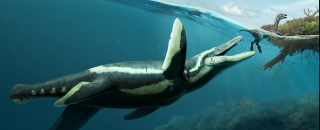DinoFest 2025: Underwater Worlds
Have you ever wondered what lurked beneath the surface of oceans, rivers, and streams during the age of dinosaurs? At NHMU's ninth-annual DinoFest on January 25-26, 2025, we explored these Underwater Worlds and examined how dinosaurs interacted with them.
We were joined by a lineup of world-class paleontologists who specialize in the diverse creatures that lived underwater alongside dinosaurs, including ichthysaurs, plesiosaurs, crocodilians, turtles, and fish. These experts offered DinoFest guests a rare, insider look at the latest and most groundbreaking discoveries from the world of paleontology.
DinoFest guests also enjoyed special access to the Paleo Preparation Lab and Paleontology Collections to get up close with incredible fossils. And community partners filled the Museum's Canyon to highlight the region's many dinosaur research and educational communities.
Guest Speakers
Check out our lineup of incredible guest speakers who helped us explore ancient Underwater Worlds.
DinoFest Keynote: Laura E. Wilson, Ph.D.
Saturday, January 25, 12 p.m. - 12:55 p.m.
Surviving Hell’s Aquarium
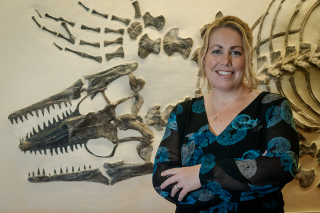
Eighty-five million years ago, central North America was covered by an ocean filled with sharks, bony fish, and marine reptiles. So how did animals that were not apex predators survive in this seaway? Looking at the internal structure of fossil sea turtle and bird bones uncovers different survival strategies among Late Cretaceous marine animals. In a world of big predators with big teeth, you better grow up fast or get the heck out of Dodge.
About the Speaker
Inspired by the natural world, Laura Wilson, Ph.D., pursues work that brings together her love of learning, teaching, and exploring. Her research focuses on reconstructing ancient marine ecosystems that evolved in a greenhouse climate and comparing them to modern systems. After 12 years in academia, Wilson realized she wanted to make a bigger impact on Earth's future. She now serves as the Executive Director of Marine Resources Council where she works to restore the Indian River Lagoon.
DinoFest Keynote: Daniel Ksepka, Ph.D.
Sunday, January 26, 12 p.m. - 12:55 p.m.
Diving Into the World of Fossil Penguins
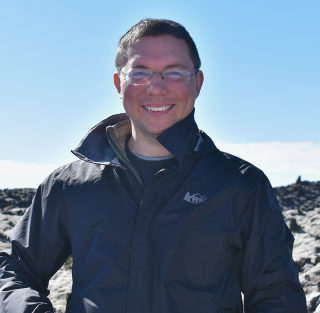
Penguins have plied the oceans for over 60 million years. These remarkable birds arose from flying ancestors but gave up flight to become flippered divers. Their fossil record reveals many unexpected twists and turns along this evolutionary journey: "giant" species weighing over 200lbs, spear-billed species, and penguins with red and grey feathers. The fossil record also reveals that today, penguins have reached their lowest point in species diversity, reinforcing conservation concerns for imperiled populations.
About the Speaker
Daniel Ksepka, Ph.D., serves as Curator at the Bruce Museum. His research focuses on the phylogenetic relationships and evolution of wing-propelled diving in penguins. Ksepka also contributes to the study of avian brain evolution and the paleoecology of the giant bony-toothed Pelagornithidae. He enjoys sharing natural history discoveries through exhibitions at the Bruce Museum and writing for American Scientist and Scientific American.
DinoBite: Neil Patrick Kelley, Ph.D.
Saturday, January 25, 1 p.m. - 1:25 p.m.
Here Be Monsters: Giant Ichthyosaurs and Their World
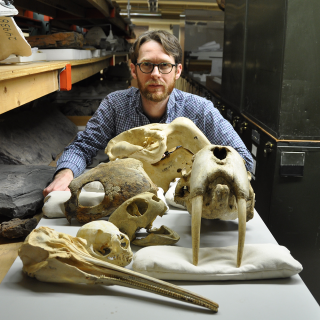
"Here Be Monsters: Giant Ichthyosaurs and Their World" delves into the evolution of giant ichthyosaurs, the first marine reptiles to reach immense sizes. Were there really ichthyosaurs as big as whales? What did they eat? Why did they go extinct? What animals did they share the seas with? Drawing on recent fossil discoveries from around the world, and across the American West, this talk explores these questions, examining the ecosystems these ocean giants inhabited and their eventual extinction.
About the Speaker
Neil Kelley, Ph.D., is a paleontologist and evolutionary biologist with a special interest in extinct marine reptiles that were the top ocean predators during the Mesozoic (the ‘Age of Dinosaurs’). He has participated in fossil excavations in China and across North America, including multiple sites in Nevada, and worked in museum collections around the world. He is an associate professor of Earth and Environmental Sciences at Vanderbilt University in Nashville, Tennessee.
DinoBite: Sanaa El-Sayed, Ph.D. Candidate
Saturday, January 25, 1:30 p.m. - 1:55 p.m.
Prehistoric Giants From Egypt
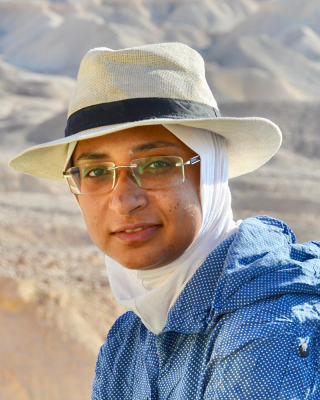
Have you ever wondered what Egypt looked like long before the time of the pharaohs? Imagine a land teeming with life, not a vast desert but a thriving world of giants on land and sea!
Join me for an exciting adventure into prehistoric Egypt, where you’ll meet incredible creatures like the mighty Spinosaurus, the ancient Tutcetus, colossal fishes, and so much more!
Through the latest discoveries by Egypt’s very own Sallam Lab team, we’ll uncover the secrets of this ancient world.
About the Speaker
Sanaa El-Sayed is among the first generation of Egyptian vertebrate paleontologists at MUVP, a leading research and education program in the Middle East. With over 40 field expeditions, she is one of the few women in Egypt leading fieldwork, inspiring others in STEM and advocating for women in science. She is the first Egyptian female student to lead an international publication on the discovery of a vertebrate fossil and a member of Sallam Lab, the first Egyptian team to unearth Egyptian dinosaurs, including Mansourasaurus.
DinoBite: Joshua Lively, Ph.D.
Saturday, January 25, 2:00 p.m. - 2:25 p.m.
Mosasaurs: From Lizards to Leviathans in 30 Million Years
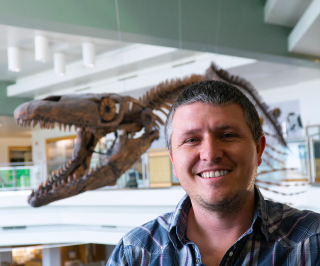
During the hothouse climate of the Cretaceous, a group of lizards known as mosasaurs took the dive into a marine lifestyle. Across 30 million years, they filled a number of ecological niches, with some being the apex predators in their marine environment. They ultimately peaked in diversity just before their extinction 66 million years ago. Come learn about our growing understanding of their origins, diversification, and the roles they played during their relatively short history.
About the Speaker
Joshua Lively, Ph.D., is the Curator of Paleontology at the Prehistoric Museum in Price, Utah. His main research interest is the spatial and temporal change in ecosystems – both freshwater and marine – during the Late Cretaceous, or last 34 million years of the Age of Dinosaurs. Lively’s specialties include turtles and mosasaurs, as both groups are well represented in the fossil record. He has spent the last 15 years conducting fieldwork in Utah and beyond.
DinoBite: Kate Ritterbush, Ph.D.
Saturday, January 25, 2:30 p.m. - 2:55 p.m.
Bringing Fossils to Life With Robots and Video Games

In the same way that fossil teeth can tell us which dinosaurs ate meat or plants, fossil sea shells of ammonites can tell us which of these squid-like animals could swim fast, maneuver well, or cruise efficiently. We make 3D models of ammonite shells and then use computers and custom robots to measure how hard it would be for these animals to swim. When we put the results into the new Ancient Oceans game using Unreal Engine, the result is a fun-filled visit to the underwater worlds of the Jurassic and beyond!
About the Speaker
Kate Ritterbush, Ph.D., is an Associate Professor at the University of Utah. She uses fossils, computers, and experiments to reconstruct ancient ocean ecosystems. Her favorite fossil animals are ammonite, whose sea shells tell us how these extinct animals might swim, glide, twirl, or bob their way through life.
DinoBite: Kiersten Formoso, Ph.D.
Sunday, January 26, 1 p.m. - 1:25 p.m.
Land Before Sea: Terrestrial Ancestry and Aquatic Morphology
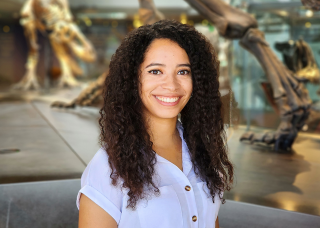
Many groups of reptiles and mammals evolved to return to aquatic environments where they swim with their bodies and tails, the surfaces of their limbs, or a combination. But the terrestrial ancestors of these secondarily aquatic animals also span a range of locomotion styles from sprawling lizards to upright ungulates. Learn about the different types of terrestrial movement and how such may have influenced the swimming styles of animals like mosasaurs, whales, plesiosaurs, and seals.
About the Speaker
Kiersten Formoso, Ph.D., is a Presidential Postdoctoral Fellow at Rutgers University in New Jersey. She received her Ph.D. from the University of Southern California in Los Angeles studying how terrestrial ancestry influences evolution into aquatic environments. Formoso is keen on the intersection of locomotion and major evolutionary transformations. Outside of her research and teaching, she is a musician, playing trombone in chamber ensembles, and really loves James Cameron movies, especially Avatar: The Way of Water.
DinoBite: Andrew Milner, BSc.
Sunday, January 26, 1:30 p.m. - 1:55 p.m.
Swimming With Dinosaurs: What Traces and Traces Tell Us About Aquatic Behaviors of Dinosaurs
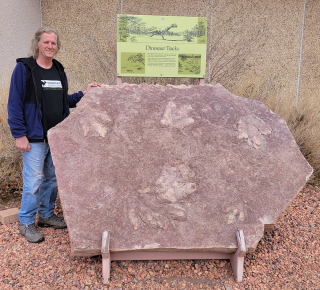
Tracks and traces of dinosaurs and other animals provide valuable information about animal behaviors. Some of the more common behavioral examples include walking, running, limping, sitting, and even swimming. There are a wide variety of aquatic animal traces known in the fossil record including those produced by different kinds of dinosaurs. Andrew will discuss the different kinds of dinosaur traces, what animals may have produced them, and how these creatures interacted with their environments.
About the Speaker
Andrew Milner, BSc, is the Lead Paleontologist and Curator at the St. George Dinosaur Discovery Site in St. George, Utah. He has been involved with this unique Early Jurassic dinosaur track site since it was discovered in February 2000, and his main focus of research is on Triassic – Early Jurassic vertebrate tracks, traces, and body fossils from across the American Southwest. Additionally, Milner has a wide variety of research interests. For example, he worked five field seasons at the Cambrian Burgess Shale in British Columbia, and he continues his research on the Late Pleistocene Champlain Sea fossils from eastern Canada.
DinoBite: Nathan Ong, Ph.D.
Sunday, January 26, 2:30 p.m. - 2:55 p.m.
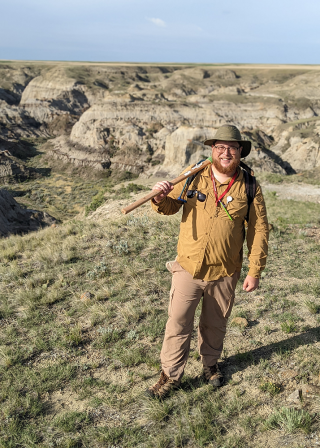
Making It by the Skin in Your Sheath: How a Turtle’s Soft Shell Helped It Survive an Apocalypse
When disaster struck 66 million years ago, turtles survived while most life, including non-avian dinosaurs, vanished. Why? Their unique shells played a critical role by storing minerals to endure long dives and hibernation during Earth's darkest days. Together, we’ll explore how these adaptations helped ancient turtles endure and what their survival tells us about resilience in times of ecological crisis.
About the Speaker
Nathan Ong, Ph.D., is a vertebrate paleontologist with expertise in turtle shell paleohistology and extinction resilience at the K/Pg boundary. A dedicated educator and Collections Assistant at the Natural History Museum of Utah, he also brings extensive experience in Utah fieldwork, data management, and museum stewardship. Ong is passionate about integrating new technology with paleontological data to uncover the microscopic anatomy and physiology of these ancient creatures.
Want More DinoFest?
If you've made it this far and are still craving more paleontology, then learn more about DinoFest here.
Or, check out our blog where you can find articles on paleontology and much more.
